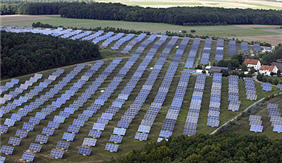 Pacific Gas & Electric, the utility that services much of northern and central California, has announced plans to buy electricity from an 800 megawatt solar panel installation, a vast project many times the size of anything currently existing.
Pacific Gas & Electric, the utility that services much of northern and central California, has announced plans to buy electricity from an 800 megawatt solar panel installation, a vast project many times the size of anything currently existing.
The move is somewhat surprising, because the expectation was that utilities would first work on building more solar thermal plants, which focus sunlight with mirrors to drive steam turbines, before building large plants with costly solar panels. At around the output of a nuclear plant, the PG&E project should provide power to several hundred thousand homes.
Economics usually drive such purchasing decisions, and they don’t always make sense for solar. Solar panels are generally expected to produce power for costs of over 15 cents per kilowatt hour when set up en masse (in smaller installations, like rooftops, the figure is higher). Roughly speaking, that’s at least three times what coal plants cost. Wind power goes for well under 10 cents per kWh, and solar thermal producers usually claim to be at 8-12 cents per kWh. Some estimates are listed here.
Thus the unusual aspect of PG&E’s deal. It would seemingly make more sense to work with other types of renewables to reach the 20 percent requirement for renewable energy the utility needs to reach by 2010. While costs for solar panels have been dropping, most companies would prefer to test smaller projects first. No numbers have been released for the installations, which will be in San Luis Obispo County.
AI Weekly
The must-read newsletter for AI and Big Data industry written by Khari Johnson, Kyle Wiggers, and Seth Colaner.
Included with VentureBeat Insider and VentureBeat VIP memberships.
One possible reason for PG&E pulling the trigger on the deal is that there is very little time left until the 2010 requirement. Solar thermal and wind require not only building the plants, but also erecting costly transmission lines from the site, sometimes several hundred miles worth. San Luis is close to the center of PG&E’s territory.
However, there’s also an existing deal with solar thermal provider Ausra to build a 177MW plant in the county, which suggests that PG&E could have contracted for more solar thermal in the same location. Instead, it went with Optisolar, a secretive thin-film solar firm that will build out a previously rumored 550MW of panels, and SunPower, a public corporation that makes standard panels, and will have 250MW of generating capacity.
Optisolar, which still says little about its technology, is also building about 100MW of capacity in Ontario, which offers hefty incentives for solar power. The thin-film silicon panels the company makes are likely very inefficient at converting sunlight to electricity, but very cheap to make.
The obvious conclusion to draw is that the economics of solar panels have changed drastically in a short time, such that giant solar farms make sense. And that seems to be the impression that all three companies are attempting to give off; for instance, a PG&E spokesperson told the NYT that the plant would be “competitive with wind power”.
However, there’s likely more to the story than is being admitted. PG&E obviously has some strong motivations to buy solar power. The question is what its contract with the two companies looks like. A standard contract involves a set purchase rate for electricity, say 12 cents per kWh for ten years, rising with inflation. That limits risk for the utility; and the risk, in turn, generally falls on the owner of the generating capacity.
What’s nearly certain is that the plants will not be competitive with wind power, which is not only very cheap, but also proven at very large scales. Solar is not yet proven at the scale PG&E is working on — and that may remain the case until the plants are built. And in the meantime, to be built at all, the plants will require a renewal of the investment tax credit, which still doesn’t look likely.
VentureBeat's mission is to be a digital town square for technical decision-makers to gain knowledge about transformative enterprise technology and transact. Learn More